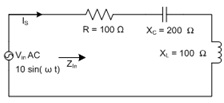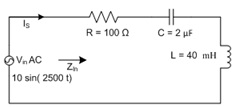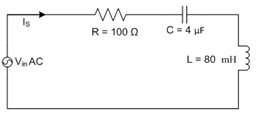Assignment:
Part 1
Question 1. The signal is 5 sin (2 pi 2000 t + 60 degrees). The amplitude of this signal is
- 5 VPP
- 3.535 VPP
- 3.535 VRMS
- 3.535 VPK
Question 2. The signal is 10 sin (2 pi 1000 t + 30 degrees). The frequency of this signal is
- 2000 Hz
- 1000 Hz
- 6280 Hz
- 10 kHz
Question 3. The signal is 5 sin (2 pi 2000 t + 60 degrees). The phase shift of this signal is
- +60 degrees
- -30 degrees
- +30 degrees
- -90 degrees
Question 4. The signal is 5 sin (2 pi 2000 t + 60 degrees). The voltage displayed on the DMM is
- 5 VPP
- 3.535 VPP
- 3.535 VRMS
- 3.535 VPK
Question 5. Inductive reactance is the opposition that an inductor shows to _______.
- alternating current
- direct current
- AC and DC
- none of the above
Question 6. In an AC circuit with reactance XC in series with a resistor the circuit current
- leads the applied voltage.
- lags the applied voltage.
- voltage and the current are in phase.
- No correct answer is listed
Question 7. For the following series AC circuit, the angle of the circuit impedance is

- 0 degrees
- +90 degrees
- +45 degrees
- -45 degrees
Question 8. For the following series AC circuit, the phase angle of the circuit current is

- 0 degrees
- +90 degrees
- -45 degrees
- +45 degrees
Question 9. For the following series AC circuit, the total circuit impedance is:

- 100 - j 100
- 100 + j 100
- 100 - j 200
- 100 + j 300
Question 10. For the parallel AC circuit shown below, find the circuit current IS . Note that Vin AC is mislabeled, it should be 10V, NOT 10 sin(ω t).

- 0.1 + j 0.1 A
- 0.1 - j 0.1 A
- 0.1 A
- j 0.1 A
Question 11. The total admittance for the following circuit is

- 0.01 - j 0.05 siemens
- 0.01 + j 0.005 siemens
- 0.01 - j 0.005 siemens
- 0.001 - j 0.005 siemens
Part 2
Question 1. Determine the resonance frequency of the following circuit to the nearest integer value.

- 563 Hz
- 1125 Hz
- 281 Hz
- 1000 Hz
Question 2. We need to purchase an inductor coil for a resonance circuit resonating at 100 MHz; the operating bandwidth is 250 kHz. What is the quality factor Q of the coil?
Question 3. The superposition theorem is used
- to calculate the short circuit current at the output of a circuit.
- to analyze any circuit with multiple sources using one at a time.
- for analyzing DC circuits only.
- for analyzing AC circuits only.
Question 4. In an audio system we need to feed the audio signal to a tweeter (a high frequency speaker). This can be accomplished by using a ______.
- band pass filter
- low pass filter
- high pass filter
- band stop filter
Question 5. The cut off frequency is also known as the ______.
- resonance frequency
- half power point
- full power point
- unity gain point
Question 6. We need to bring down the voltage from 120 V to 12 V. The transformer turns ratio is _______.
Question 7. The role of a capacitor at the output of the bridge rectifier in an AC to DC converter is
- to regulate the DC voltage.
- for smoothing the ripple.
- to eliminate the transformer.
- to double up the DC voltage.
Question 8. What does the number "10" in the description of the sine wave 10sin(100 t) represent?
Question 9. How do you find the total reactance of multiple inductive reactances connected in parallel?
Part 3
Question 1. What is the phase angle of a capacitive susceptance?
Question 2. Can we calculate the inductor value given the circuit resonance frequency? If your answer is no, explain why.
Question 3. What is Kirchhoff's voltage Law?
Question 4. What is the output side component in a simple RC low pass filter?
Question 5. Name an electronic product that you use every day that has a regulated DC power supply.
Question 6. What is the turns ratio for an isolation transformer?
Part 4
Question 1. Describe the relationship between peak voltage, peak-to-peak voltage and rms voltage. Include in the discussion which values can be demonstrated with the laboratory test equipment.
Question 2. Describe the operation of the series RC circuit. The discussion must address phase angle relationships of current and voltage. The answer must include the effect of source frequency on the voltage drops across the resistor and the capacitor at very low and very high frequency values.
Question 3. Describe the characteristics of the series RC filter circuit with the output across the resistive component. Distinguish the pass and stop bands with reference to the cutoff frequency. Also, state what happens to the circuit complex impedance at the cutoff frequency.